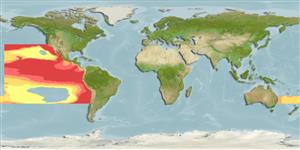>
Myctophiformes (Lanternfishes) >
Myctophidae (Lanternfishes) > Lampanyctinae
Etymology: Triphoturus: Greek, triphos = with three + Greek, oura = tail (Ref. 45335).
More on author: Gilbert.
Environment: milieu / climate zone / depth range / distribution range
Écologie
marin; profondeur 25 - ? m (Ref. 82347). Subtropical; 37°N - 34°S
Eastern Pacific: California, USA (Ref. 7182) and Gulf of California to Peru and Chile.
Taille / Poids / Âge
Maturity: Lm ? range ? - ? cm
Max length : 7.0 cm TL mâle / non sexé; (Ref. )
Description synthétique
Clés d'identification | Morphologie | Morphométrie
Épines dorsales (Total) : 0; Rayons mous dorsaux (Total) : 13 - 16; Épines anales: 0; Rayons mous anaux: 14 - 17; Vertèbres: 33 - 35. Branchiostegal rays: 8-11 (Ref. 31442).
Epipelagic to mesopelagic (Ref. 31442). Oviparous, with planktonic eggs and larvae (Ref. 31442). Lipid content is 14.5 % in fresh body weight and wax ester is 82.2 % in total lipids (Ref. 9197).
Life cycle and mating behavior
Maturities | Reproduction | Spawnings | Egg(s) | Fecundities | Larves
Moser, H.G. and E.H. Ahlstrom, 1996. Myctophidae: lanternfishes. p. 387-475. In H.G. Moser (ed.) The early stages of fishes in the California Current Region. California Cooperative Oceanic Fisheries Investigations (CalCOFI) Atlas No. 33. 1505 p. (Ref. 31442)
Statut dans la liste rouge de l'IUCN (Ref. 130435)
Menace pour l'homme
Harmless
Utilisations par l'homme
Outils
Articles particuliers
Télécharger en XML
Sources Internet
Estimates based on models
Preferred temperature (Ref.
123201): 7.8 - 14.3, mean 11.5 °C (based on 84 cells).
Phylogenetic diversity index (Ref.
82804): PD
50 = 0.6250 [Uniqueness, from 0.5 = low to 2.0 = high].
Bayesian length-weight: a=0.00550 (0.00320 - 0.00944), b=3.18 (3.03 - 3.33), in cm total length, based on LWR estimates for this species & (Sub)family-body (Ref.
93245).
Niveau trophique (Ref.
69278): 3.3 ±0.40 se; based on food items.
Generation time: 1.8 ( na - na) years. Estimated as median ln(3)/K based on 2
growth studies.
Résilience (Ref.
120179): Haut, temps minimum de doublement de population inférieur à 15 mois (Preliminary K or Fecundity.).
Fishing Vulnerability (Ref.
59153): Low vulnerability (22 of 100).
